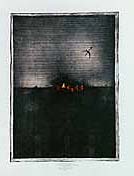|
The purpose of the artwork has been to document the artists' collective and individual reactions to the horror of armed aggression on Bosnia. The artists themselves are from all of Bosnia's ethnic backgrounds. There are eighteen artists who participated in the project. Each of them has created an original artwork in printmaking medium. The prints have been made in intaglio techniques (aquatint, etching, sugar-lift). There are 35 signed portfolios printed within the completed edition of the project. The first showing of the art project was held in Sarajevo in September of 1992. Sarajevo '92 was also exhibited in major European cities: Barcelona, Paris, Brussels, Vienna, Stockholm, Oslo, Munich, Strassbourg during 1993 and 1994. There have been seven exhibits of the art show in the United States at the following locations: • Washington
Trade and Convention Center, Seattle, Washington, • Blackfish Gallery, Portland, Oregon, June 1995 • Haverford
Library Exhibit Hall, Haverford College, Haverford, • Exhibition
Hall, Middle Eastern Studies Association Conference, • National Arts Club, New York, New York, January 1996 • World Center Gallery, Bethesda, Maryland, May 1996 • Northampton Center for the Arts, Northampton, Massachusetts, August 1996 Statement
by Dr. Nikola Kovac As we know, painters use a universal language; their messages move easily across national and political borders. In a multinational community, this universal language has a special cultural mission: to neutralize ideological myths and national prejudices. It is true that all cultural creations bear the marks of their origin and spiritual sources, but they serve the same aim and common ideal of beauty. Hence the language of art, as an eminently cultural creation, establishes links of spiritual communication even where political measures interrupt them. Sarajevo's internationally renown graphic artists, united by their spiritual and moral protest against division, violence, and the spirit of intolerance, confirm in the best possible way how noble ideas find an aesthetically adequate expression in the universal language of art. In this way, art testifies that a human being cannot be reduced to history, but the human essence is an integral part of the order of beauty and its spontaneous currents. The Sarajevo '92 collection was born at the crossroads of struggle and creation--two principles which determine the rhythm of life and slows the blind march of destiny. Freedom and beauty are the driving forces of this dynamic and its final aims. The Sarajevo artists--remaining faithful to their personal signature--evoke aggression, the collapse of reason, the monster's traces, the demonic wave--wished, with their personal revolt, to mark the paths to freedom while keeping intact the symbols of beauty. The meaning of their enterprise and their achievement lie at the junction of these two principles. Finally, through their collective effort they confirm that the idea of togetherness in a multinational country rests upon the consciousness of a continuity of living spiritual values. This is a pledge of their moral engagement and a condition of their artistic mission.
|
 he
exhibition Sarajevo '92 was initiated by the faculty of the Academy
of Fine Arts in Sarajevo and was made under the war conditions from
June to September 1992. The sponsors of the project are the Art Institute
of the Academy of Fine Arts and the International Peace Center in Sarajevo.
he
exhibition Sarajevo '92 was initiated by the faculty of the Academy
of Fine Arts in Sarajevo and was made under the war conditions from
June to September 1992. The sponsors of the project are the Art Institute
of the Academy of Fine Arts and the International Peace Center in Sarajevo.


